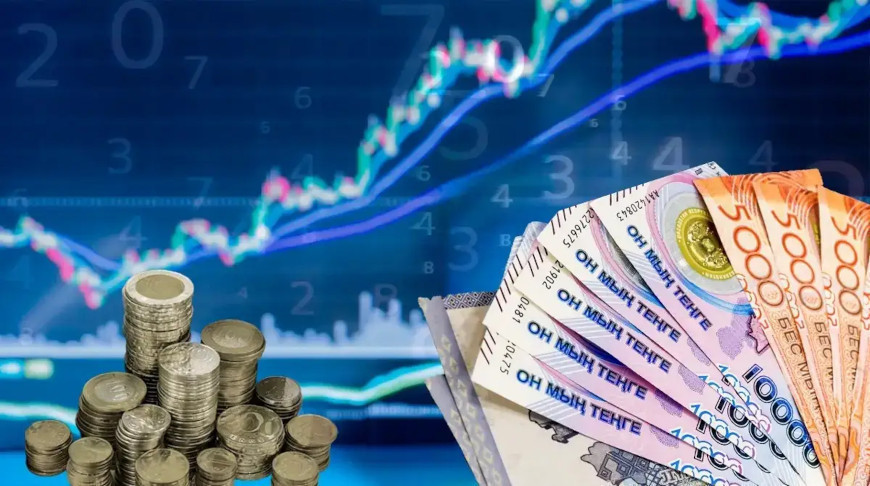
ASTANA, 4 December (BelTA - Kazinform) - In November, the National Bank of
Kazakhstan reported an acceleration in inflation over the past month,
reaching 8.5%. This was attributed to rising prices in partner
countries, military conflicts around the world, and a decline in global
trade volumes. Will inflation continue to rise, or will we follow the
government’s scenario of reaching 5%? This is discussed in a report by
Kazinform News Agency correspondent.
However, in October, the downward trend in inflation was interrupted. By the end of October, inflation accelerated by 0.2 percentage points, reaching 8.5% year-on-year.
One of the main reasons for the rise in inflation was an increase in prices for paid services, which grew by 14.3% year-on-year, compared to 13.6% in the previous month. Prices for non-food items also changed, rising by 7.8% (compared to 7.6% in September 2024), while food prices increased by 4.9% (5.1% in September 2024).
The Bureau of National Statistics of Kazakhstan compared utility prices for October 2024 with those from October of the previous year. Tariffs for cold water rose by 60.3%, central heating by 33.6%, and water drainage by 26.9% year-on-year.
At the end of November, Deputy Prime Minister and Minister of National Economy of Kazakhstan Nurlan Baibazarov spoke about measures being taken in the country to curb inflation.
“The monetary tool for controlling inflation is very effective. It is recognized worldwide. High rates can be maintained to control inflation, and this is being done, essentially. However, the other issue is that it directly affects economic growth. Therefore, the government is working to reduce dependence on imports. Inflation is indeed rising. It is driven by two main channels: food and non-food goods. These two categories contribute about two-thirds of overall inflation, excluding paid services,” says Nurlan Baibazarov at a Senate meeting.
He emphasized that the government is actively working to attract investments in food production.
Targeting and Forecasts
The Ministry of National Economy previously announced the country’s socio-economic development forecast for 2025–2029. In 2025, inflation in Kazakhstan is projected to be within the range of 5.5–7.5%, decreasing to 5–6% in 2026, and further declining to 5% in 2027–2029.
This forecast is based on a baseline scenario assuming an oil price of $75 per barrel and a dollar exchange rate of 470 tenge [as of December 1, the exchange rate for the U.S. dollar approached 511 tenge, - Editor’s note]. According to Baibazarov, real GDP growth is expected to reach 5.6% in 2025, with an average annual GDP growth of 5.4% over the next five years. Nominal GDP is projected to increase from 150.8 trillion tenge in 2025 to 234.2 trillion tenge in 2029.
Changes in the Base Rate
To regulate inflation, the state employs targeting—a monetary policy regime aimed at achieving price stability. The primary tool of the National Bank of Kazakhstan for curbing inflation is maintaining or raising the base rate [the interest rate it charges commercial banks for loans, - Editor’s note]. Generally, when inflation rises, the base rate is increased; when inflation falls, the rate is lowered.
In October, the National Bank announced that the base rate would remain at 14.25%. However, on November 29, the regulator raised the rate to 15.25%. This decision was made considering updated forecasts and an assessment of inflationary risk balances. The financial regulator's statement noted that amid volatility in financial and energy markets, the National Bank will closely monitor the need for additional monetary tightening to expedite the return of inflation to a sustainable slowdown trajectory and achieve the target of 5%.
The next scheduled decision by the National Bank of Kazakhstan on the base rate will be announced on January 17, 2025.
Expert Opinions
In the National Bank’s report, it was noted that in October 2024, inflation expectations among the population for the next 12 months decreased to 12.5%, compared to 14.1% in September 2024. This decline reflects a reduced impact of exchange rate factors. At the same time, as the financial regulator notes, consumer sentiment has worsened slightly “due to a decrease in assessments of the country’s development prospects and people’s personal financial situation in the coming year.”
Dmitry Sochin, a board member of the “Qazaq Association of Minority Shareholders” (QAMS), emphasized that achieving inflation targets requires stricter fiscal policy and its alignment with the National Bank’s monetary policy.
“Kazakhstan has historically struggled with high inflation, largely due to imbalances in monetary and fiscal policies. In recent years, inflation has been exacerbated by excessive stimulus measures taken by both the National Bank and the Government in 2021–2022. Additional pressure came from external factors, such as high global inflation, which was imported into the country. It’s worth noting that countries with stricter fiscal and monetary policies managed to avoid such significant price increases, underscoring the importance of coordinated economic measures,” comments Dmitry Sochin.
As an example, the expert cited Chile, a country with an economy similar to Kazakhstan’s. This unitary state has a population of 19.6 million and strives to keep its budget deficit within reasonable limits. Additionally, Chile implements a fairly strict monetary policy, with an inflation target of 3%. In February 2023, Chile's inflation was at 14.1%, but it has since decreased to 4.7%.
According to Dmitry Sochin, there was once discussion in Kazakhstan about the need for synchronization between the National Bank and the Government within a counter-cyclical policy framework. However, in practice, inflation control efforts have been placed solely on the National Bank, whose tools are limited. In his view, Kazakhstan is likely to only reach the upper range of the inflation forecasts provided by the Ministry of National Economy.
“These forecasts align with the inflation targets set by the National Bank. However, achieving them is only possible if current macroeconomic conditions are maintained and there are at least minimal signs of budget deficit control. Given persistent pro-inflationary risks, particularly imported inflation and domestic imbalances, actual inflation figures could approach the upper limit of the forecast range, especially in 2025–2026,” says the QAMS board member.
Macroeconomics expert and Director for public administration and policy at the Desht Analytical Center, Alibek Konkakov, highlights a persistent gap between the National Bank’s inflation targets and actual inflation figures.
This demonstrates that the National Bank’s inflation expectations in recent years have often differed from real figures.
“The last time the inflation target was met was in 2019 and early 2020. Based on this, the Ministry of National Economy’s inflation forecast is unlikely to be achieved. Moreover, external conditions may worsen. For instance, we saw exchange rate fluctuations immediately after Trump’s election,” he added.
Konkakov also pointed out that an optimal inflation target for Kazakhstan would be 5%. While inflation itself is not inherently negative, its level must always be controlled to avoid unchecked growth.
Balancing inflation and economic growth
Financial analyst Arman Beisembayev noted that an inflation range of 7.5–8.5% is historically normal for Kazakhstan. However, he cautioned that a positive trend in slowing inflation might not materialize next year due to imbalanced budgetary spending.
“Spending from the National Fund has not stopped, which means that unbacked money continues to enter the economy, further fueling inflation… We see that the National Bank has worked in this direction and has brought inflation back to the corridor where it historically belonged. That is, a range of 6 to 9% is realistic for our economy,” says Beisembayev.
If Kazakhstan manages to meet the National Bank’s mandate to reduce inflation to 5%, it would break the country’s historical inflation trend.“It’s good when inflation is at 5% with 6% economic growth, as this results in a real welfare increase of 1%. It’s bad when the economy grows by 4% and inflation is at 8%. To accelerate economic growth, interest rates need to be lowered, but we cannot do this because inflation in the country is high. If we lower the interest rate, inflation will automatically begin to rise at a faster pace. And in any case, we will have to return to raising the rate,” he concluded.
Global inflation trends
In 2024, a ranking of countries with the highest inflation rates was published in the media. The analysis was based on data from national statistical agencies across 193 countries, with 151 included in the final sample. According to the results for 2023, Argentina overtook long-time leader Venezuela as the country with the highest inflation.
In Argentina, a sharp price surge occurred due to currency devaluation, with inflation accelerating to 211% from 161% in November. Lebanon ranked second, where annual price growth reached 192%, an increase of 70% compared to the previous year. Venezuela came in third, experiencing a slowdown in inflation to 190% from 234% the year before.
Türkiye also faced peak inflation this year, exceeding 60%, driven by a sharp depreciation of the national currency. Turkish President Recep Tayyip Erdoğan, despite his long-standing commitment to low-interest-rate policies, supported recent monetary tightening measures by the country’s central bank. Interest rates were raised to 40% and later to 50% in an effort to control inflation.
However, Erdoğan recently reiterated his goal to return to low-rate policies as soon as inflation begins to slow. He advocates for low base rates as part of his vision to create a "production and employment economy" free from the burden of high borrowing costs. Erdoğan also vowed to "break the vicious cycle of interest rates, inflation, and exchange rates." In his view, lowering rates will make credit more accessible and stimulate private sector growth.
According to official data, Türkiye's year-on-year inflation rate dropped to 48.58% in October 2024. Nevertheless, this level remains high. The Turkish government aims to bring inflation down to single digits by the end of 2026.
In conclusion, it should be noted that Kazakhstan continues to face pro-inflationary risks. Concerns persist that the inflation rate in 2025 will remain above the National Bank's targets.
Autumn Figures
In
September, the National Bank of Kazakhstan announced that annual
inflation had continued its slow decline in August and September, noting
that the pace of reduction was insufficient. In August, inflation stood
at 8.4%, while in September it decreased to 8.3%. The peak of annual
inflation in recent years occurred in February 2023, reaching 21.3%.However, in October, the downward trend in inflation was interrupted. By the end of October, inflation accelerated by 0.2 percentage points, reaching 8.5% year-on-year.
One of the main reasons for the rise in inflation was an increase in prices for paid services, which grew by 14.3% year-on-year, compared to 13.6% in the previous month. Prices for non-food items also changed, rising by 7.8% (compared to 7.6% in September 2024), while food prices increased by 4.9% (5.1% in September 2024).
The Bureau of National Statistics of Kazakhstan compared utility prices for October 2024 with those from October of the previous year. Tariffs for cold water rose by 60.3%, central heating by 33.6%, and water drainage by 26.9% year-on-year.
At the end of November, Deputy Prime Minister and Minister of National Economy of Kazakhstan Nurlan Baibazarov spoke about measures being taken in the country to curb inflation.
“The monetary tool for controlling inflation is very effective. It is recognized worldwide. High rates can be maintained to control inflation, and this is being done, essentially. However, the other issue is that it directly affects economic growth. Therefore, the government is working to reduce dependence on imports. Inflation is indeed rising. It is driven by two main channels: food and non-food goods. These two categories contribute about two-thirds of overall inflation, excluding paid services,” says Nurlan Baibazarov at a Senate meeting.
He emphasized that the government is actively working to attract investments in food production.
Targeting and Forecasts
The Ministry of National Economy previously announced the country’s socio-economic development forecast for 2025–2029. In 2025, inflation in Kazakhstan is projected to be within the range of 5.5–7.5%, decreasing to 5–6% in 2026, and further declining to 5% in 2027–2029.
This forecast is based on a baseline scenario assuming an oil price of $75 per barrel and a dollar exchange rate of 470 tenge [as of December 1, the exchange rate for the U.S. dollar approached 511 tenge, - Editor’s note]. According to Baibazarov, real GDP growth is expected to reach 5.6% in 2025, with an average annual GDP growth of 5.4% over the next five years. Nominal GDP is projected to increase from 150.8 trillion tenge in 2025 to 234.2 trillion tenge in 2029.
Changes in the Base Rate
To regulate inflation, the state employs targeting—a monetary policy regime aimed at achieving price stability. The primary tool of the National Bank of Kazakhstan for curbing inflation is maintaining or raising the base rate [the interest rate it charges commercial banks for loans, - Editor’s note]. Generally, when inflation rises, the base rate is increased; when inflation falls, the rate is lowered.
In October, the National Bank announced that the base rate would remain at 14.25%. However, on November 29, the regulator raised the rate to 15.25%. This decision was made considering updated forecasts and an assessment of inflationary risk balances. The financial regulator's statement noted that amid volatility in financial and energy markets, the National Bank will closely monitor the need for additional monetary tightening to expedite the return of inflation to a sustainable slowdown trajectory and achieve the target of 5%.
The next scheduled decision by the National Bank of Kazakhstan on the base rate will be announced on January 17, 2025.
Expert Opinions
In the National Bank’s report, it was noted that in October 2024, inflation expectations among the population for the next 12 months decreased to 12.5%, compared to 14.1% in September 2024. This decline reflects a reduced impact of exchange rate factors. At the same time, as the financial regulator notes, consumer sentiment has worsened slightly “due to a decrease in assessments of the country’s development prospects and people’s personal financial situation in the coming year.”
Dmitry Sochin, a board member of the “Qazaq Association of Minority Shareholders” (QAMS), emphasized that achieving inflation targets requires stricter fiscal policy and its alignment with the National Bank’s monetary policy.
“Kazakhstan has historically struggled with high inflation, largely due to imbalances in monetary and fiscal policies. In recent years, inflation has been exacerbated by excessive stimulus measures taken by both the National Bank and the Government in 2021–2022. Additional pressure came from external factors, such as high global inflation, which was imported into the country. It’s worth noting that countries with stricter fiscal and monetary policies managed to avoid such significant price increases, underscoring the importance of coordinated economic measures,” comments Dmitry Sochin.
As an example, the expert cited Chile, a country with an economy similar to Kazakhstan’s. This unitary state has a population of 19.6 million and strives to keep its budget deficit within reasonable limits. Additionally, Chile implements a fairly strict monetary policy, with an inflation target of 3%. In February 2023, Chile's inflation was at 14.1%, but it has since decreased to 4.7%.
According to Dmitry Sochin, there was once discussion in Kazakhstan about the need for synchronization between the National Bank and the Government within a counter-cyclical policy framework. However, in practice, inflation control efforts have been placed solely on the National Bank, whose tools are limited. In his view, Kazakhstan is likely to only reach the upper range of the inflation forecasts provided by the Ministry of National Economy.
“These forecasts align with the inflation targets set by the National Bank. However, achieving them is only possible if current macroeconomic conditions are maintained and there are at least minimal signs of budget deficit control. Given persistent pro-inflationary risks, particularly imported inflation and domestic imbalances, actual inflation figures could approach the upper limit of the forecast range, especially in 2025–2026,” says the QAMS board member.
Macroeconomics expert and Director for public administration and policy at the Desht Analytical Center, Alibek Konkakov, highlights a persistent gap between the National Bank’s inflation targets and actual inflation figures.
This demonstrates that the National Bank’s inflation expectations in recent years have often differed from real figures.
“The last time the inflation target was met was in 2019 and early 2020. Based on this, the Ministry of National Economy’s inflation forecast is unlikely to be achieved. Moreover, external conditions may worsen. For instance, we saw exchange rate fluctuations immediately after Trump’s election,” he added.
Konkakov also pointed out that an optimal inflation target for Kazakhstan would be 5%. While inflation itself is not inherently negative, its level must always be controlled to avoid unchecked growth.
Balancing inflation and economic growth
Financial analyst Arman Beisembayev noted that an inflation range of 7.5–8.5% is historically normal for Kazakhstan. However, he cautioned that a positive trend in slowing inflation might not materialize next year due to imbalanced budgetary spending.
“Spending from the National Fund has not stopped, which means that unbacked money continues to enter the economy, further fueling inflation… We see that the National Bank has worked in this direction and has brought inflation back to the corridor where it historically belonged. That is, a range of 6 to 9% is realistic for our economy,” says Beisembayev.
If Kazakhstan manages to meet the National Bank’s mandate to reduce inflation to 5%, it would break the country’s historical inflation trend.“It’s good when inflation is at 5% with 6% economic growth, as this results in a real welfare increase of 1%. It’s bad when the economy grows by 4% and inflation is at 8%. To accelerate economic growth, interest rates need to be lowered, but we cannot do this because inflation in the country is high. If we lower the interest rate, inflation will automatically begin to rise at a faster pace. And in any case, we will have to return to raising the rate,” he concluded.
Global inflation trends
In 2024, a ranking of countries with the highest inflation rates was published in the media. The analysis was based on data from national statistical agencies across 193 countries, with 151 included in the final sample. According to the results for 2023, Argentina overtook long-time leader Venezuela as the country with the highest inflation.
In Argentina, a sharp price surge occurred due to currency devaluation, with inflation accelerating to 211% from 161% in November. Lebanon ranked second, where annual price growth reached 192%, an increase of 70% compared to the previous year. Venezuela came in third, experiencing a slowdown in inflation to 190% from 234% the year before.
Türkiye also faced peak inflation this year, exceeding 60%, driven by a sharp depreciation of the national currency. Turkish President Recep Tayyip Erdoğan, despite his long-standing commitment to low-interest-rate policies, supported recent monetary tightening measures by the country’s central bank. Interest rates were raised to 40% and later to 50% in an effort to control inflation.
However, Erdoğan recently reiterated his goal to return to low-rate policies as soon as inflation begins to slow. He advocates for low base rates as part of his vision to create a "production and employment economy" free from the burden of high borrowing costs. Erdoğan also vowed to "break the vicious cycle of interest rates, inflation, and exchange rates." In his view, lowering rates will make credit more accessible and stimulate private sector growth.
According to official data, Türkiye's year-on-year inflation rate dropped to 48.58% in October 2024. Nevertheless, this level remains high. The Turkish government aims to bring inflation down to single digits by the end of 2026.
In conclusion, it should be noted that Kazakhstan continues to face pro-inflationary risks. Concerns persist that the inflation rate in 2025 will remain above the National Bank's targets.













